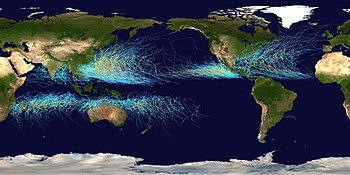
| Part of a series on |
| Tropical cyclones |
|---|
 |
|
Outline Media coverage |
Tropical cyclones regularly affect the coastlines of most of Earth's major bodies of water along the Atlantic, Pacific, and Indian oceans. Also known as hurricanes, typhoons, or other names, tropical cyclones have caused significant destruction and loss of human life, resulting in about 2 million deaths since the 19th century. Powerful cyclones that make landfall – moving from the ocean to over land – are some of the most impactful, although that is not always the case. An average of 86 tropical cyclones of tropical storm intensity form annually worldwide, with 47 reaching hurricane/typhoon strength, and 20 becoming intense tropical cyclones, super typhoons, or major hurricanes (at least of Category 3 intensity).
In Africa, tropical cyclones can originate from tropical waves generated over the Sahara Desert, or otherwise strike the Horn of Africa and Southern Africa. Cyclone Idai in March 2019 hit central Mozambique, becoming the deadliest tropical cyclone on record in Africa, with 1,302 fatalities, and damage estimated at US$2.2 billion.[nb 1] Réunion island, located east of Southern Africa, experiences some of the wettest tropical cyclones on record. In January 1980, Cyclone Hyacinthe produced 6,083 mm (239.5 in) of rain over 15 days, which was the largest rain total recorded from a tropical cyclone on record. In Asia, tropical cyclones from the Indian and Pacific oceans regularly affect some of the most populated countries on Earth. In 1970, a cyclone struck Bangladesh, then known as East Pakistan, producing a 6.1 m (20 ft) storm surge that killed at least 300,000 people; this made it the deadliest tropical cyclone on record. In October 2019, Typhoon Hagibis struck the Japanese island of Honshu and inflicted US$15 billion in damage, making it the costliest storm on record in Japan. The islands that comprise Oceania, from Australia to French Polynesia, are routinely affected by tropical cyclones. In Indonesia, a cyclone struck the island of Flores in April 1973, killing 1,653 people, making it the deadliest tropical cyclone recorded in the Southern Hemisphere.
Atlantic and Pacific hurricanes regularly affect North America. In the United States, hurricanes Katrina in 2005 and Harvey in 2017 are the country's costliest ever natural disasters, with monetary damage estimated at US$125 billion. Katrina struck Louisiana and largely destroyed the city of New Orleans, while Harvey caused significant flooding in southeastern Texas after it dropped 60.58 in (1,539 mm) of rainfall; this was the highest rainfall total on record in the country. Europe is rarely affected by tropical cyclones; however, the continent regularly encounters storms after they transitioned into extratropical cyclones. Only one tropical depression – Vince in 2005 – struck Spain, and only one subtropical cyclone – Subtropical Storm Alpha in 2020 – struck Portugal. Occasionally, there are tropical-like cyclones in the Mediterranean Sea. The northern portion of South America experiences occasional tropical cyclones, with 173 fatalities from Tropical Storm Bret in August 1993. The South Atlantic Ocean is generally inhospitable to the formation of a tropical storm. However, in March 2004, Hurricane Catarina struck southeastern Brazil as the first hurricane on record in the South Atlantic Ocean.
Cite error: There are <ref group=nb> tags on this page, but the references will not show without a {{reflist|group=nb}} template (see the help page).
© MMXXIII Rich X Search. We shall prevail. All rights reserved. Rich X Search
